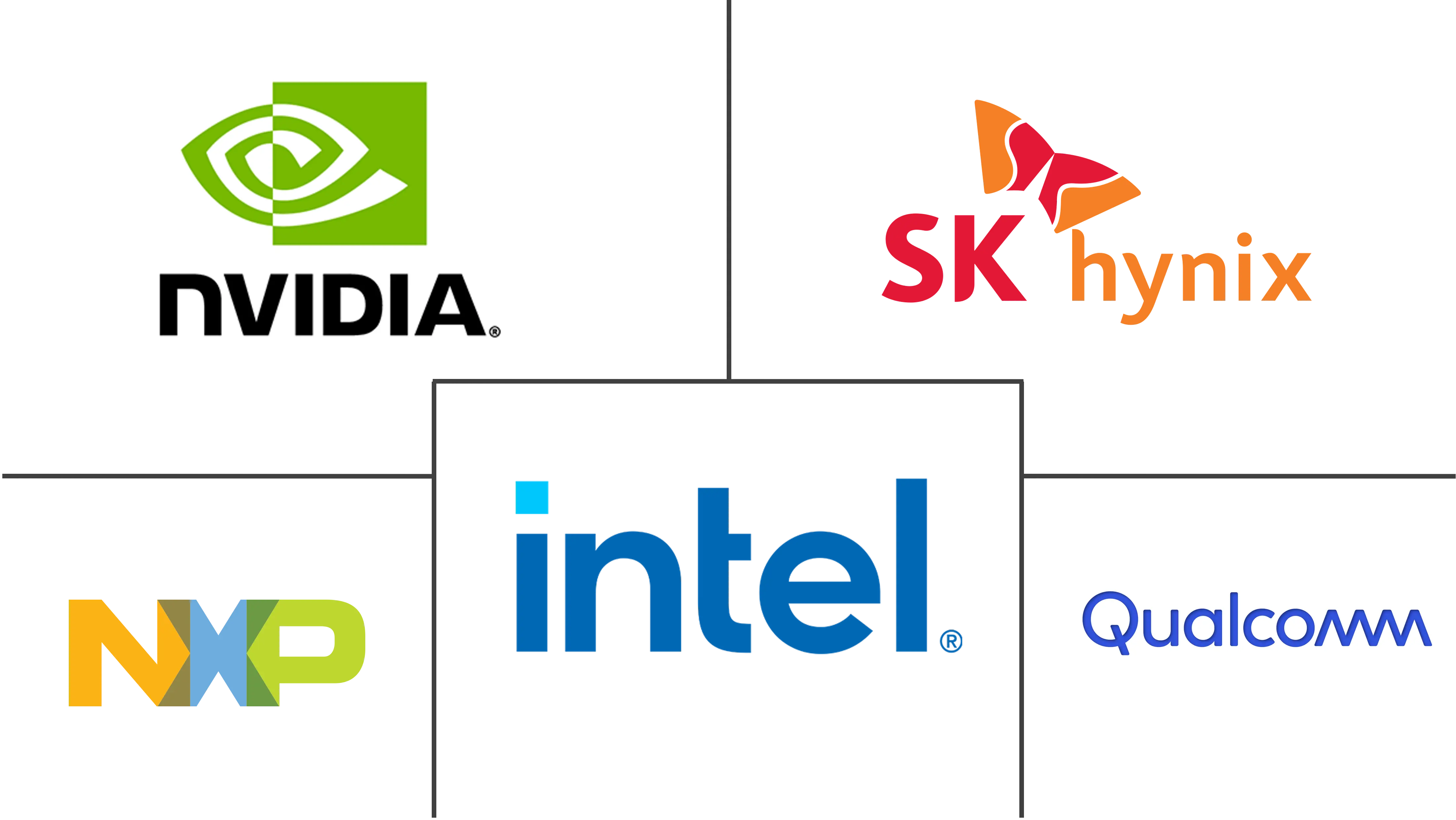Size and Share of Semiconductor Device Market For Processing Applications
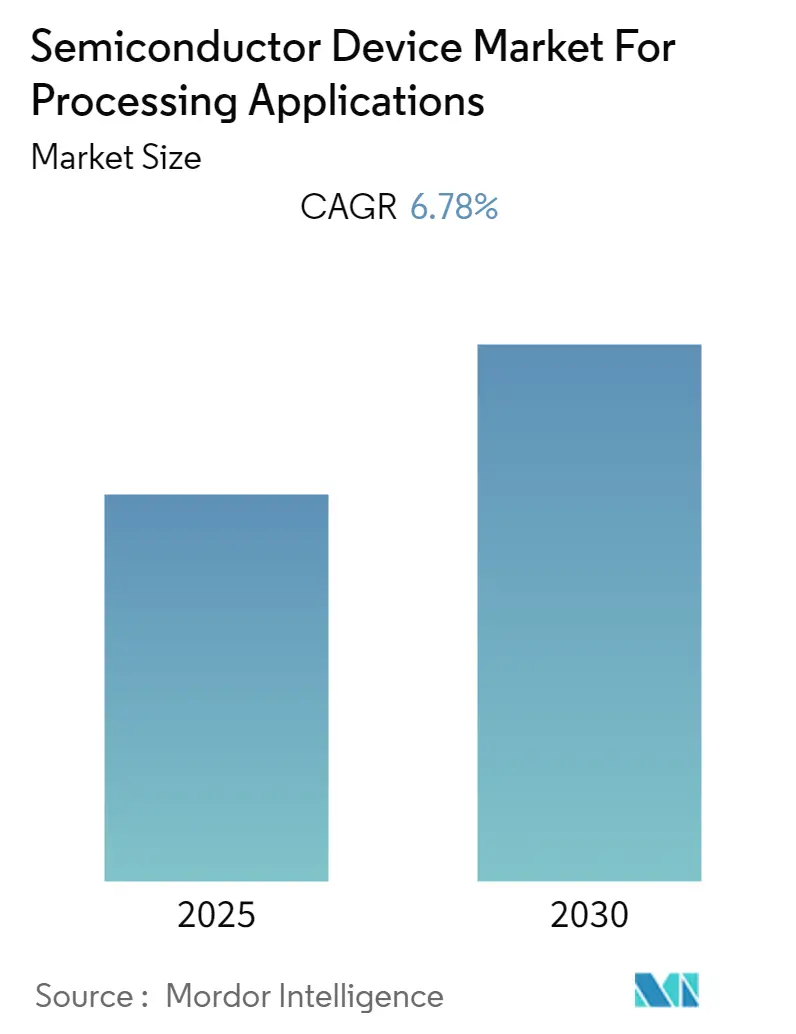
Analysis of Semiconductor Device Market For Processing Applications by Mordor Intelligence
The Semiconductor Device Market For Processing Applications Industry is expected to register a CAGR of 6.78% during the forecast period.
The semiconductor industry is witnessing rapid growth, with semiconductors emerging as the basic building blocks of all modern technology. The advancements and innovations in this field are resulting in a direct impact on all downstream technologies.
- Semiconductors form the building blocks of any computing device. For instance, many transistors make up a logic gate that processes binary information, the code of ones and zeros computers use. These semiconductor devices can also retain binary code as memory blocks.
- With the growing popularity of computing devices like smartphones, PCs, and laptops, the amount of data generated and communicated across a global network, often in real-time, has grown rapidly. To keep up with this growth, High-performance computing (HPC) has become crucial and is seeing significant growth. HPC refers to processing data and performing complex calculations at high speeds to solve performance-intensive problems. Many semiconductor devices like sensors and optoelectronics are required to enable HPC applications.
- High-performance computing (HPC) has emerged as an important growth driver for the semiconductor industry. For instance, in May 2024, Mindgrove Technologies, a semiconductor startup backed by Peak XV Partners, announced on Sunday the launch of what they assert to be India's inaugural commercial high-performance SoC (system on chip). Dubbed Secure IoT, this chip is tailored for IoT devices and is projected to be priced approximately 30% lower than its counterparts in the market.
- Also, semiconductors serve as a primary component for data centers. Different devices are used, like central processing units (CPUs), graphics processing units (GPUs), memory, chips for network infrastructure, and power management. Therefore, semiconductor memory chips are the key devices for storing and managing data in data centers, and their performance is crucial to the success of data center operations.
Insights and Trends of Semiconductor Device Market For Processing Applications
Memory Segment Under Integrated Circuits is Expected to Boost The Demand in The Market
- The semiconductor memory is a digital electronic data storage device implemented with semiconductor electronic devices on an integrated circuit. Different types of memory are available, such as DRAM, SRAM, Nor Flash, NAND Flash, ROM, and EPROM. They find widespread application in digital consumer products like PCs, laptops, cameras, and phones.
- The increasing demand for data centers is also bolstering the demand for memory components. Currently, large data center projects in North America have contributed to the strong demand for memory, such as DRAM. However, according to the measure of data center space per user, China's internet data centers are poised to grow to at least 22 times that of the United States or at least 10 times the current space of Japan. Hence, DRAM has a significant opportunity for growth and thus is impacting the semiconductor device industry.
- Further, the growth of the portable systems market attracted the semiconductor industry's interest in non-volatile memory (NVM) technologies for mass storage applications. The rise in demand for greater efficiency, faster memory access, and low power consumption are some of the significant factors driving the NVM market growth. There is an increasing need for NVM in data center applications to protect data losses from a sudden power outage. With the growth of data centers, the adoption of next-generation non-volatile memory is also expected to increase, driving market growth.
- Moreover, according to WSTS, In 2022, it is projected that revenue from memory component sales will amount to USD 134.41 billion, and in 2021 the recorded revenue of USD 154.84 billion. However, the revenue from memory component sales decreased, with an estimated amount of USD 111.62 billion, but it is likely to grow in the near future, and by the end of 2023, it will achieve good growth. Such factors are likely to boost the market growth.
- Samsung participates in partnerships; end users may be sure that various device suppliers and vertically integrated hardware and software firms will support its upcoming storage solutions. For instance, in March 2022, Samsung Electronics and Western Digital agreed to work together to standardize and promote next-generation data placement, processing, and fabrics (D2PF) storage technologies. They hope that by taking these steps, the industry will be able to concentrate on a wide range of applications that will ultimately provide customers with more value.
- Also, in July 2022, Micron Technology, Inc. announced that it had begun volume production of the world's first 232-layer NAND, built with industry-leading innovations to drive unprecedented performance for storage solutions. The company's 232-layer NAND is a watershed moment for storage innovation as the first proof of the capability to scale 3D NAND to more than 200 layers in production.
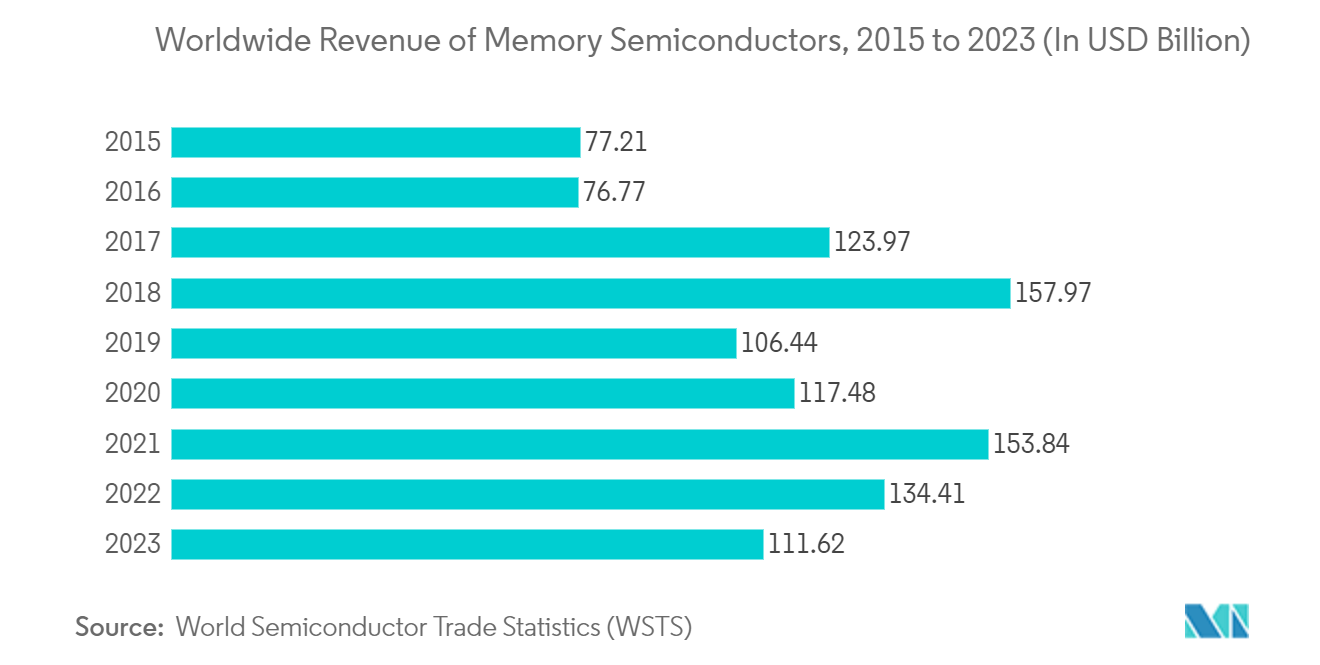
European Region Expected to Witness the Significant Growth
- The European region is home to some of the most crucial technology hubs across the globe and a critical driver and adopter of modern technology. The increasing penetration of advanced technologies and the increasing adoption of semiconductors drives market growth in the region.
- With the rise of the Internet of Things (IoT), semiconductor devices are being incorporated into all types of devices, with a wider range of computing and data storage applications. Demand for these devices is also steadily increasing. Materials and architecture are steadily evolving to improve the performance of cutting-edge memory and logic devices, power semiconductor devices, and various types of sensors.
- Furthermore, the rollout of 5G is perceived to be the enabler of IoT connectivity, automation, and edge technologies. New devices in this smarter standard will require fabs to produce higher-performing wafers with even greater capacity for memory and storage.
- 5G networks and technology are further revolutionizing wireless communications by transforming existing market sectors and industries. As per the company, between 2021 and 2025, 5G will drive up to EUR 2.0 trillion (USD 2.17 trillion) in total new sales across all major industries in the European economy. As such, new devices that enable 5G will require fabs to produce higher-performing wafers with even greater capacity for memory and storage.
- In March 2022, Intel issued the first phase of its EUR 80 billion (USD 86.84 billion) investment plan in the EU over the next decade across the semiconductor value chain, including R&D, manufacturing, and packaging technologies. Further in this investment, the company plans to invest approximately EUR 17 billion (USD 18.45 billion) in establishing a semiconductor fab mega-site in Germany, as well as the development of a new R&D and design facility in France, and to invest in R&D, manufacturing, and foundry services in Italy, Poland, Ireland, and Spain.
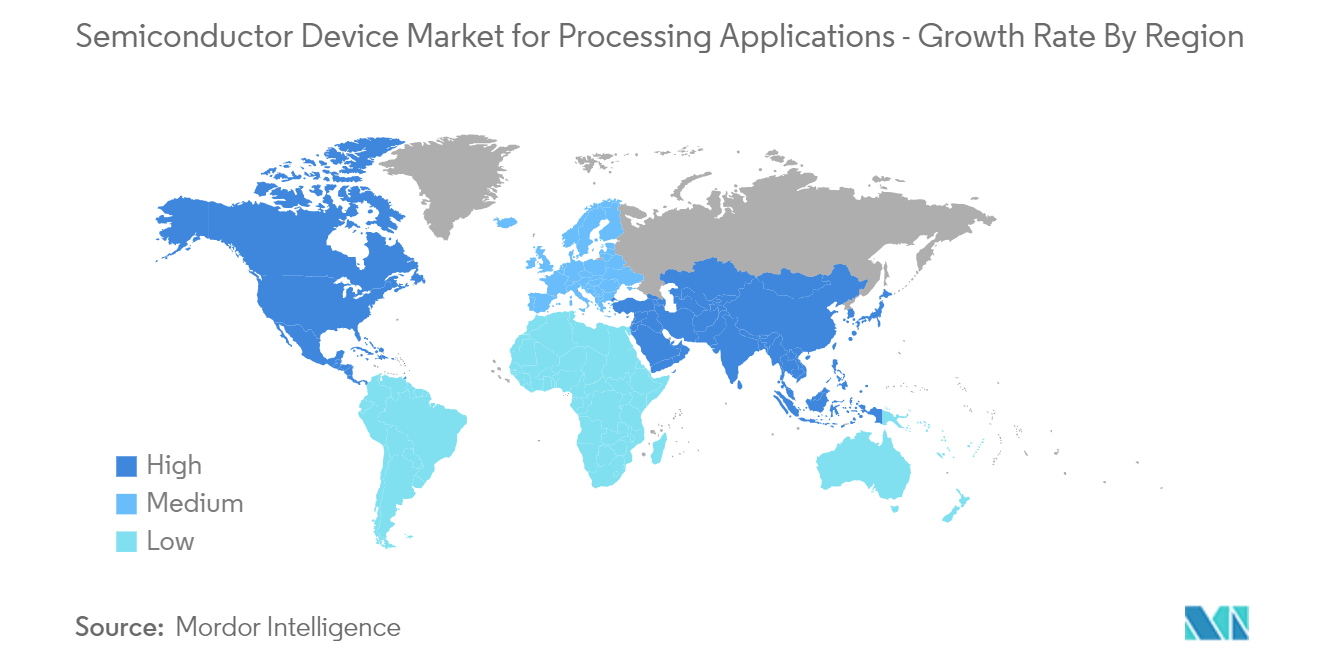
Competitive Landscape
The semiconductor device market for processing applications is experiencing moderate fragmentation, with several competitors navigating fluctuations amidst growing consolidation, technological advancements, and evolving geopolitical scenarios. This heightened competition is set to intensify in a market where establishing a sustainable competitive advantage through innovation is of paramount importance. Given the expectations of quality from end-users in the semiconductor manufacturing sector, brand identity plays a pivotal role in this landscape.
The market penetration levels are notably high, primarily due to the presence of significant market incumbents such as Intel Corporation, Nvidia Corporation, Kyocera Corporation, Qualcomm Technologies Inc., and other industry leaders.
In April 2022, SK Hynix Inc. introduced its latest solid-state drive (SSD), known as the P5530, designed for data centers in collaboration with its San-Jose-based subsidiary, Solidigm. SSDs leverage flash memory to store data, and this innovative device combines SK Hynix's 128-layer 4D NAND, a core product, with Solidigm's SSD controller.
In March 2022, Samsung Electronics and Western Digital reached an agreement to collaborate on standardizing and promoting next-generation data placement, processing, and fabrics (D2PF) storage technologies. Their joint efforts aim to streamline industry practices, allowing for a broader array of applications that ultimately deliver greater value to customers.
In January 2022, Kioxia Corporation announced the launch of Universal Flash Storage (UFS) Ver. 3.1 embedded flash memory devices. These devices harness the company's pioneering 4-bit per cell quad-level-cell (QLC) technology, which has the capability to achieve the highest densities available in a single package. This technology is particularly suited for high-density applications like high-end smartphones
Leaders of Semiconductor Device Market For Processing Applications
-
Intel Corporation
-
Nvidia Corporation
-
Qualcomm Incorporated
-
NXP Semiconductors NV
-
SK Hynix Inc.
- *Disclaimer: Major Players sorted in no particular order
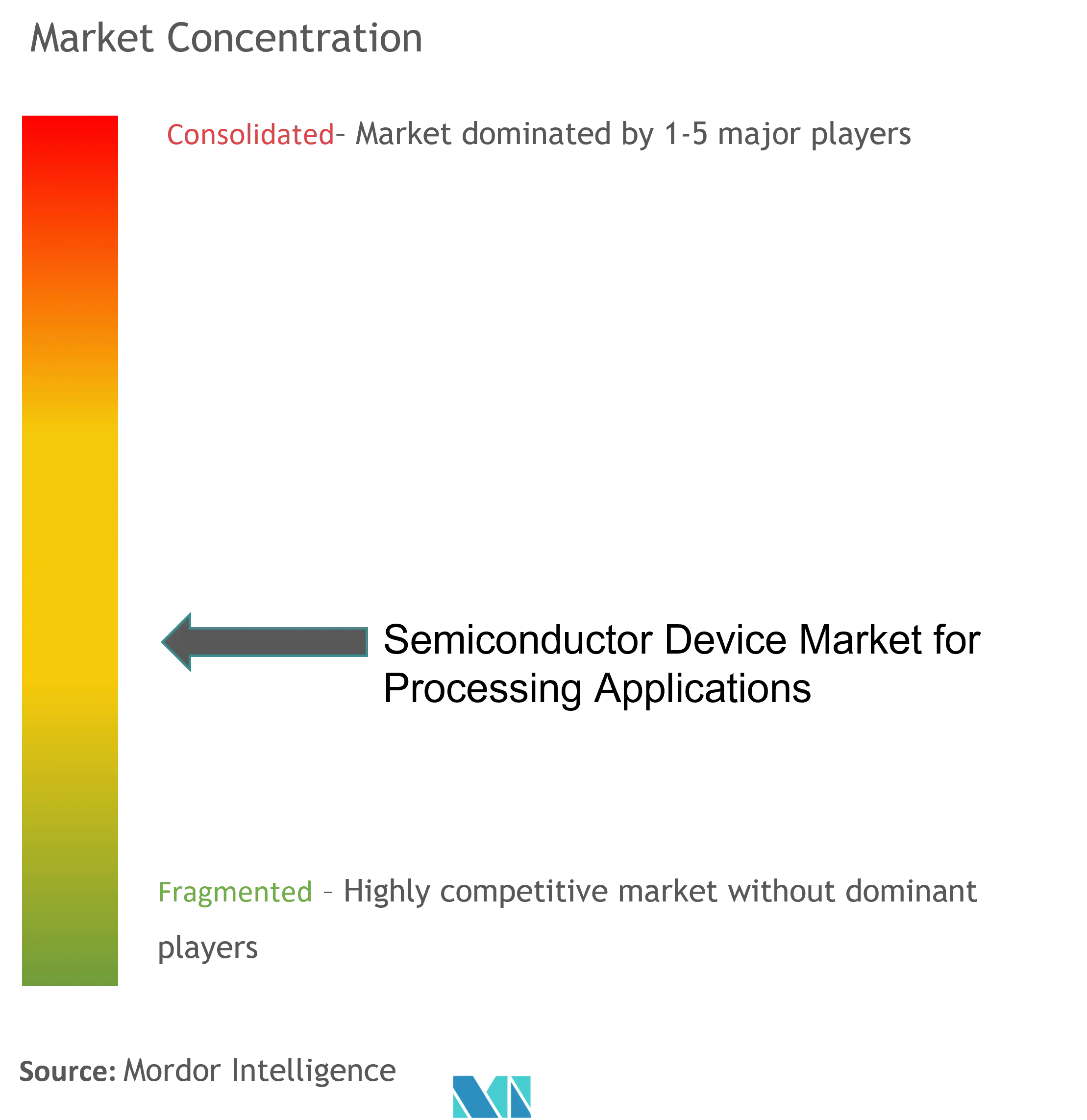
Recent Industry Developments
- April 2024 - Sony Semiconductor Solutions Corporation, a subsidiary of Sony, has initiated operations in February 2024 at its new fab, located within the premises of Sony Device Technology (Thailand) Co., Ltd. ("SDT"). SDT primarily handles the assembly processes of semiconductors. The move, which involves several production lines, is part of Sony's strategy to bolster its production capacity and streamline operations.
- December 2023 - Hitachi High-Tech Corporation ("Hitachi High-Tech") unveiled its latest innovation, the GT2000 high-precision electron beam metrology system. Leveraging its leading position in CD-SEM technology, Hitachi High-Tech introduces the GT2000, designed specifically for advanced 3D semiconductor devices. The system features state-of-the-art detection systems and incorporates advanced functions for imaging High-NA EUV resist wafers, focusing on minimizing damage and enhancing yield during mass production.
Scope of Report on Semiconductor Device Market For Processing Applications
Semiconductor devices are electronic components that are made of semiconducting material. This is employed in the fabrication of transistors, diodes, and other basic functional units of an integrated circuit (IC). Semiconductors are broadly classified into two categories: silicon-based devices, which include the majority of traditional CMOS technology, and first-generation III-V compound semiconductor technologies such as gallium arsenide (GaAs), indium phosphorous acid (InP), and others, which offer higher performance at lower power consumption.
The semiconductor device market for processing applications is segmented by device type (discrete semiconductors, optoelectronics, sensors, integrated circuits) into which integrated circuits are further segmented into (analog, logic, memory, and micro), micro divided into (microprocessors (MPU), microcontrollers (MCU), and digital signal processors), and by geography (North America, Latin America, Europe, Asia-Pacific, Middle East and Africa).
The market sizes and forecasts are provided in terms of value USD for all the above segments.
| Discrete Semiconductors | ||
| Optoelectronics | ||
| Sensors | ||
| Integrated Circuits | Analog | |
| Logic | ||
| Memory | ||
| Micro | Microprocessors (MPU) | |
| Microcontrollers (MCU) | ||
| Digital Signal Processors | ||
| North America |
| Europe |
| Asia |
| Australia and New Zealand |
| By Device Type | Discrete Semiconductors | ||
| Optoelectronics | |||
| Sensors | |||
| Integrated Circuits | Analog | ||
| Logic | |||
| Memory | |||
| Micro | Microprocessors (MPU) | ||
| Microcontrollers (MCU) | |||
| Digital Signal Processors | |||
| By Geography | North America | ||
| Europe | |||
| Asia | |||
| Australia and New Zealand | |||
Key Questions Answered in the Report
What is the current Semiconductor Device Market For Processing Applications Industry size?
The Semiconductor Device Market For Processing Applications Industry is projected to register a CAGR of 6.78% during the forecast period (2025-2030)
Who are the key players in Semiconductor Device Market For Processing Applications Industry?
Intel Corporation, Nvidia Corporation, Qualcomm Incorporated, NXP Semiconductors NV and SK Hynix Inc. are the major companies operating in the Semiconductor Device Market For Processing Applications Industry.
Which is the fastest growing region in Semiconductor Device Market For Processing Applications Industry?
Europe is estimated to grow at the highest CAGR over the forecast period (2025-2030).
Which region has the biggest share in Semiconductor Device Market For Processing Applications Industry?
In 2025, the North America accounts for the largest market share in Semiconductor Device Market For Processing Applications Industry.
What years does this Semiconductor Device Market For Processing Applications Industry cover?
The report covers the Semiconductor Device Market For Processing Applications Industry historical market size for years: 2019, 2020, 2021, 2022, 2023 and 2024. The report also forecasts the Semiconductor Device Market For Processing Applications Industry size for years: 2025, 2026, 2027, 2028, 2029 and 2030.
Page last updated on:
Report on Semiconductor Device Market For Processing Applications
Statistics for the 2025 Semiconductor Device For Processing Applications market share, size and revenue growth rate, created by Mordor Intelligence™ Industry Reports. Semiconductor Device For Processing Applications analysis includes a market forecast outlook for 2025 to 2030 and historical overview. Get a sample of this industry analysis as a free report PDF download.
